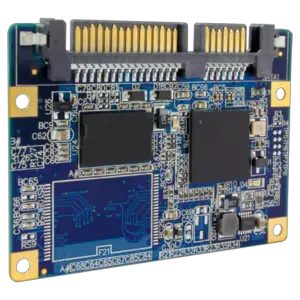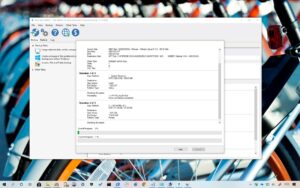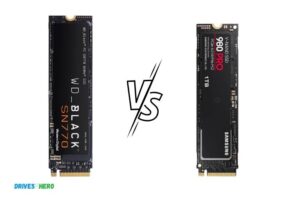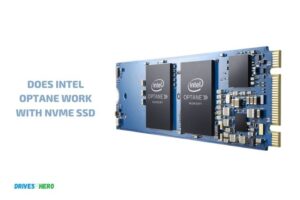Nvme Ssd Vs Sas Ssd: Which is Better for Speed?
When comparing NVMe SSDs with SAS SSDs, the NVMe SSDs are significantly faster and more efficient.
While SAS SSDs have been industry-standard for years, the emergence of NVMe SSDs, with their high-speed parallelism and low latency, has changed the game.
NVMe (Non-Volatile Memory Express) is a communications interface and driver that defines a command set and feature set for PCIe-based SSDs.
NVMe SSDs connect directly to the CPU via the PCIe bus, which means they bypass traditional storage controller bottlenecks, resulting in improved speed and performance.
On the other hand, SAS (Serial Attached SCSI) SSDs are known for their reliability and are widely used in enterprise environments.
They connect through the SAS controller, which can cause some latency and slowdowns compared to NVMe SSDs.
In conclusion, NVMe SSDs with their superior speed and efficiency are more suitable for high-performance computing, gaming, and applications where speed and performance are a
8 Feature Of Nvme SSD and SAS SSD
| Feature | NVMe SSD | SAS SSD |
|---|---|---|
| Interface | PCIe | SAS |
| Speed | Up to 3500 MB/s | Up to 12Gb/s |
| Latency | Lower latency due to its simplified data path | Higher latency |
| Maximum Capacity | Up to 16TB | Up to 60TB |
| Power Consumption | Lower compared to SAS SSD | Higher compared to NVMe SSD |
| Cost | Pricier than SAS SSD | Cheaper than NVMe SSD |
| Form Factor | U.2, M.2, and AIC | 2.5 or 3.5 inches |
| Use Case | High performance computing and server applications | Traditional storage arrays and server applications |
Key Takeaway
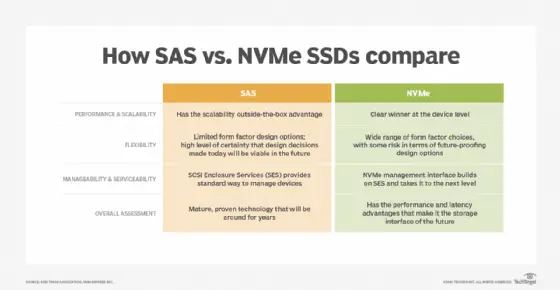
Five Facts About: Nvme SSD and SAS SSD
Understanding Nvme Ssd And Sas Ssd
Nvme SSD and SAS SSD are two different types of solid-state drives used in computer storage.
Nvme SSDs offer faster speeds and lower latency, making them ideal for high-performance applications, while SAS SSDs are known for their reliability and scalability.
Understanding the differences between the two can help you choose the right SSD for your specific needs.
Nvme Ssd and Sas Ssd are both types of solid-state drives (Ssds) commonly used in the world of data storage.
While they serve the same purpose, they have distinct characteristics that set them apart.
In this section, we will delve deeper into each type, discussing their key features and benefits.
What Are Nvme Ssd And Sas Ssd?
Nvme Ssd:
- Nvme stands for Non-Volatile Memory Express, which is a communication protocol designed specifically for solid-state drives.
- It utilizes the PCIe (Peripheral Component Interconnect Express) interface, allowing for faster data transfer speeds.
- Nvme Ssds offer incredibly low latency, which means they can access and retrieve data much quicker than other storage options.
- With its parallel processing capability, Nvme can handle multiple input/output operations simultaneously, making it ideal for high-performance computing and demanding workloads.
Sas Ssd:
- Sas stands for Serial Attached SCSI (Small Computer System Interface), which is an interface used for connecting storage devices to a computer system.
- Sas Ssds are known for their reliability and endurance, making them suitable for enterprise-level storage solutions.
- They are designed to handle heavy workloads and are commonly used in environments that require excellent data integrity and fault-tolerance.
- Sas Ssds offer good performance, high data transfer rates, and support for a wide range of storage capacities.
Key Features And Benefits Of Nvme Ssd
Faster Transfer Speeds:
Nvme Ssds can achieve significantly higher read and write speeds compared to traditional hard drives or even other types of Ssds.
This allows for swift data access, resulting in faster boot times, application load times, and overall system responsiveness.
Low Latency:
The ultra-low latency of Nvme Ssds ensures minimal delays when retrieving data, making them ideal for tasks that require rapid access to large amounts of information, such as gaming, 3D rendering, and video editing.
Improved Power Efficiency:
Nvme Ssds consume less power than their Sas counterparts, contributing to better energy efficiency and prolonged battery life for devices like laptops and mobile devices.
Compact Form Factor:
Nvme Ssds are generally smaller and lighter than Sas Ssds, making them suitable for space-constrained systems like ultrabooks and compact desktop builds.
Future-Proof Technology:
With ongoing advancements in Nvme technology, these Ssds are well-positioned for even faster speeds and increased capacities in the future.
Key Features And Benefits Of Sas Ssd
Enterprise-Grade Reliability:
Sas Ssds are built with a focus on reliability, providing enterprise-level durability and fault-tolerance.
They are designed to handle the demanding workloads of data centers and server environments.
Data Integrity:
Sas Ssds offer features like error correction and detection mechanisms, ensuring the integrity of stored data. This is crucial in mission-critical applications that require highly reliable storage.
Wide Compatibility:
Sas Ssds can be easily integrated into existing Sas infrastructure, enabling seamless integration with servers, storage arrays, and other Sas-based systems.
Excellent Endurance:
With robust build quality and advanced wear-leveling algorithms, Sas Ssds are built to handle heavy workloads, making them suitable for write-intensive applications like databases and content delivery networks (CDNs).
Scalability:
Sas Ssds offer a wide range of storage capacities, allowing for scalable storage solutions that can accommodate the growing needs of businesses and enterprises.
Nvme Ssds boast high-speed performance, low latency, and compact form factors, making them ideal for consumer applications.
On the other hand, Sas Ssds excel in reliability, data integrity, and endurance, making them a preferred choice for enterprise-level storage solutions.
Performance And Speed Comparison
The performance and speed of NVMe SSDs compared to SAS SSDs is a much-debated topic.
NVMe SSDs provide a significant boost in speed, with faster data transfer rates and lower latency, making them the preferred choice for high-performance computing and data-intensive applications.
On the other hand, SAS SSDs offer a more cost-effective solution for traditional storage needs without compromising on reliability and durability.
Ultimately, the choice between NVMe and SAS SSDs depends on the specific requirements of your application.
Speed Benchmarks: Nvme Ssd Vs Sas Ssd
When it comes to performance and speed, comparing NVMe SSDs and SAS SSDs is essential.
Let’s take a closer look at the speed benchmarks to understand the key differences between these two storage options:
NVMe SSDs:
- Lightning-fast read and write speeds: NVMe SSDs utilize the PCIe interface, enabling them to offer exceptional performance. With read and write speeds reaching up to 3500MB/s, NVMe SSDs ensure rapid data transfer and retrieval.
- Reduced latency: Thanks to its direct connection to the CPU, NVMe SSDs minimize latency and improve overall system responsiveness.
- Enhanced multitasking capabilities: NVMe SSDs handle multiple IO operations simultaneously, resulting in smoother multitasking experiences.
SAS SSDs:
- Competitive speed performance: SAS SSDs, while not as fast as NVMe SSDs, still deliver impressive speeds of up to 1200MB/s. This makes them a suitable option in environments where slight speed differences are not crucial.
- Reliable and durable: SAS SSDs are known for their reliability and durability, making them ideal for enterprise applications that require consistent performance over extended periods.
- Seamless compatibility: SAS SSDs maintain backward compatibility with traditional SAS infrastructure, allowing for effortless integration into existing systems.
Response Time Analysis: Nvme Ssd Vs Sas Ssd
The response time analysis sheds light on how NVMe SSDs and SAS SSDs perform when it comes to latency and response speed:
NVMe SSDs:
- Ultra-low latency: The direct connection of NVMe SSDs to the CPU significantly reduces response times, delivering near-instantaneous data access and retrieval.
- Quick application responsiveness: With NVMe SSDs, applications load swiftly, allowing for enhanced productivity and a seamless user experience.
- Ideal for resource-intensive tasks: The exceptional response times of NVMe SSDs make them perfect for workloads that require rapid data processing, such as virtualization and big data analytics.
SAS SSDs:
- Reliable response times: While not as low as NVMe SSDs, SAS SSDs still offer consistent response times, ensuring predictable performance in enterprise environments.
- Stable latency under heavy workloads: SAS SSDs maintain steady latency levels even during intensive workloads, resulting in smooth operations without significant performance fluctuations.
- Suitable for a range of applications: SAS SSDs excel in enterprise applications and databases that prioritize stability, reliability, and consistent performance.
Iops Comparison: Nvme Ssd Vs Sas Ssd
IOPS (Input/Output Operations Per Second) is an essential metric to consider when comparing NVMe SSDs and SAS SSDs:
NVMe SSDs:
- High IOPS performance: NVMe SSDs outshine SAS SSDs in terms of IOPS, enabling a significantly larger number of simultaneous read and write operations.
- Accelerated data processing: The superior IOPS capabilities of NVMe SSDs make them invaluable in scenarios where speed and throughput are paramount, such as gaming, video editing, and server applications.
- Excellent for heavy workloads: NVMe SSDs handle resource-intensive workloads with ease, ensuring smooth performance even under demanding conditions.
SAS SSDs:
- Adequate IOPS for enterprise applications: While not as high as NVMe SSDs, SAS SSDs still offer respectable IOPS performance, making them suitable for a wide range of enterprise applications.
- Reliable and consistent operations: SAS SSDs deliver consistent IOPS, maintaining stability in environments that require predictable and steady performance.
- Ideal for database applications: SAS SSDs excel in database applications where data integrity, reliability, and data consistency are vital factors.
Overall, NVMe SSDs provide unparalleled speed, low latency, and exceptional IOPS performance, making them a top choice for applications demanding lightning-fast data processing.
However, SAS SSDs offer competitive speeds, reliability, and compatibility with traditional SAS infrastructure, making them a reliable option for enterprise environments.
Reliability And Durability Evaluation
Reliability and durability evaluations reveal the stark differences between NVMe SSD and SAS SSD.
The performance, lifespan, and stability of NVMe SSD make it a superior choice compared to its SAS counterpart.
When it comes to comparing NVMe SSDs and SAS SSDs, it’s crucial to assess their reliability and durability.
Let’s delve into two key factors: endurance and lifespan, as well as error correction and data integrity.
Additionally, we’ll explore the impact of workload and temperature on these drives’ reliability.
Endurance And Lifespan: Nvme Ssd Vs Sas Ssd
Durability is a primary concern when selecting an SSD.
Here are key points to consider when comparing NVMe SSD and SAS SSD endurance and lifespan:
- NVMe SSDs offer exceptional endurance due to their advanced NAND flash memory technology. These drives are designed to handle intensive workloads and frequent data transfers without sacrificing performance.
- SAS SSDs also have notable endurance characteristics, making them suitable for enterprise applications. They perform well under demanding workloads, providing a high level of reliability.
- Both NVMe SSDs and SAS SSDs come with endurance ratings, indicating the total amount of data that can be written to the drive over its lifespan. It’s crucial to consider these ratings based on your specific needs and workload requirements.
Error Correction And Data Integrity: Nvme Ssd Vs Sas Ssd
To ensure accurate and reliable data storage, error correction and data integrity are vital features of SSDs.
Here’s how NVMe SSDs and SAS SSDs compare in this aspect:
- NVMe SSDs employ advanced error correction mechanisms, such as Low-Density Parity Check (LDPC) codes, to detect and correct errors during data transmission. This results in higher data integrity and reduced chances of data corruption.
- SAS SSDs also incorporate error correction techniques, including cyclic redundancy check (CRC), to maintain data integrity. These drives offer robust protection against errors and ensure the safety of stored information.
- Both NVMe SSDs and SAS SSDs prioritize data reliability through sophisticated error correction mechanisms, providing peace of mind when it comes to the safety of your valuable data.
Impact Of Workload And Temperature On Reliability
The workload and operating temperature can significantly impact the reliability of SSDs.
Here are key considerations regarding this aspect:
NVMe SSDs excel in handling heavy workloads, making them ideal for applications requiring fast data access and high processing speeds.
These drives reliably manage strenuous operations, such as data analytics and virtualization.
SAS SSDs are also designed to handle demanding workloads effectively. They are commonly used in enterprise storage environments that require consistent performance and reliability.
Temperature is an important factor that affects SSD reliability. NVMe SSDs, with their efficient heat dissipation capabilities, can maintain optimal operating temperatures even under heavy workloads.
SAS SSDs, known for their robust design, are also capable of operating within a wide temperature range without compromising reliability.
Both NVMe SSDs and SAS SSDs possess high reliability and durability features. NVMe SSDs offer exceptional endurance and leverage advanced error correction mechanisms, ensuring optimal data integrity.
On the other hand, SAS SSDs are known for their reliability under demanding workloads and resistance to varying operating temperatures.
Understanding your specific requirements and workload characteristics will help you make an informed decision between these two SSD types.
Scalability And Compatibility Analysis
Scalability and compatibility analysis between NVMe SSD and SAS SSD showcases their differences in terms of performance, speed, and storage capacity.
NVMe SSD sets a new benchmark for faster data transfer rates and optimal scalability, while SAS SSD remains a reliable and compatible option for traditional storage needs.
Choose wisely based on your specific requirements:
The scalability and compatibility of NVMe SSDs and SAS SSDs are crucial factors to consider when choosing the right storage solution for your needs.
Let’s take a look at how these two technologies stack up in terms of scalability options, compatibility with different systems and interfaces, as well as interoperability considerations.
Scalability Options And Limitations: Nvme Ssd Vs Sas Ssd
NVMe SSD:
- Highly scalable with the ability to connect multiple SSDs to a single system
- Supports parallel processing, allowing for faster data transfer rates
- Can accommodate high workloads and demanding applications
- Provides increased throughput and reduced latency
SAS SSD:
- Allows for daisy-chaining of drives, enabling easy expansion of storage capacity
- Supports multi-pathing, providing redundancy and fault tolerance
- Suitable for enterprise storage environments requiring high reliability and availability
- Offers a balance between performance and scalability
Compatibility With Different Systems And Interfaces
NVMe SSD:
- Requires systems with NVMe support, limiting compatibility to newer hardware
- Uses PCIe (Peripheral Component Interconnect Express) interface for high-speed data transfer
- Compatible with modern operating systems such as Windows 10 and Linux distributions
- Some older systems and software may not have NVMe compatibility
SAS SSD:
- Compatible with a wide range of systems, including both newer and older hardware
- Utilizes SAS (Serial Attached SCSI) interface for data transfer
- Supports legacy systems and software with SAS connectivity
- Offers flexibility in connecting to different servers, workstations, and storage arrays
Interoperability Considerations: Nvme Ssd Vs Sas Ssd
NVMe SSD:
- Interoperable with NVMe-enabled systems, ensuring seamless integration
- Supports data sharing and data mobility across different NVMe devices
- Enhances interoperability between storage, compute, and networking components
- Enables efficient communication between NVMe drives and NVMe storage controllers
SAS SSD:
- Interoperability with SAS-enabled systems, promoting compatibility across various platforms
- Facilitates interoperability between SAS drives, SAS controllers, and SAS expanders
- Allows for integration with existing SAS infrastructures, ensuring smooth transitions
- Provides interoperability assurances in enterprise storage environments
Both NVMe SSDs and SAS SSDs offer unique scalability and compatibility features that cater to different storage requirements.
Consider factors such as system compatibility, interface support, and scalability options when selecting the right SSD technology for your specific needs.
Use Cases And Recommendations
When comparing use cases and making recommendations, it’s important to consider the differences between NVMe SSDs and SAS SSDs.
These two storage technologies offer distinct advantages and understanding their strengths can help optimize your system’s performance.
Best Use Cases For Nvme Ssd:
Gaming and multimedia editing:
Nvme SSDs offer blazing-fast read and write speeds, making them ideal for gamers and multimedia professionals who need quick access to large files, such as game installations, high-resolution videos, and graphics.
Database and server applications:
Nvme SSDs excel in handling intense workloads, making them perfect for database servers and applications that require rapid data processing and retrieval.
Virtualization:
Nvme SSDs’ high performance and low latency make them a great choice for virtual environments, enabling speedy boot times, efficient virtual machine management, and seamless multi-tasking.
Best Use Cases For Sas Ssd:
Enterprise storage:
Sas SSDs are commonly used in enterprise storage systems where reliability, data integrity, and consistent performance are crucial.
They are ideal for mission-critical workloads and enterprise applications requiring high input/output operations per second (IOPS).
Data centers:
Sas SSDs’ high endurance and reliability make them well-suited for data center environments, where data protection and consistent performance are vital for uninterrupted operations.
High-capacity storage:
Sas SSDs also come in larger capacities, making them suitable for applications that require massive storage, such as video surveillance, archiving, and data backup.
Factors To Consider When Choosing Between Nvme Ssd And Sas Ssd:
Performance requirements:
Consider the specific performance needs of your applications and workloads. If you require ultra-fast data access and low latency, Nvme SSDs are the better choice.
But if you prioritize consistency, reliability, and endurance, Sas SSDs may be a more suitable option.
Compatibility:
Verify the compatibility of your system with the respective SSD interfaces. Nvme SSDs use the NVMe protocol and require an NVMe-enabled motherboard or PCIe adapter, while Sas SSDs connect via the SAS interface and often require specific controllers.
Budget:
Nvme SSDs are generally more expensive than Sas SSDs. Assess your budget constraints and determine if the higher speed and performance offered by Nvme SSDs justify the extra cost for your use case.
If not, Sas SSDs can provide a more cost-effective solution.
Scalability:
Consider your future storage needs and growth potential. Nvme SSDs’ scalability is limited by the PCIe lanes available on your system, while Sas SSDs can support a greater number of drives via SAS expanders.
Reliability and endurance requirements:
If your applications demand high levels of reliability and endurance, especially in write-intensive scenarios, Sas SSDs’ robustness can be advantageous.
Remember, thoroughly evaluating the specific use cases, performance requirements, compatibility, budget, scalability, and reliability needs can help you make an informed decision between Nvme SSDs and Sas SSDs for your storage solution.
Cost And Affordability Comparison
In the comparison between NVMe SSD and SAS SSD, the cost and affordability play a significant role.
Both options differ in terms of pricing, with NVMe SSD generally being more expensive due to its higher performance capabilities.
However, SAS SSDs offer a more budget-friendly choice without compromising on reliability.
Nvme Ssd Vs Sas Ssd
When it comes to selecting the right storage solution for your enterprise, cost is always a significant consideration.
Let’s dive into the cost and affordability comparison between NVMe SSD and SAS SSD.
Price Differences: Nvme Ssd Vs Sas Ssd
When looking at the price differences between NVMe SSD and SAS SSD, several factors contribute to the variation.
Here are the key points to consider:
- Flash Memory Technology: NVMe SSDs utilize the latest flash memory technology, which tends to be more expensive compared to the older technology used in SAS SSDs.
- Performance: NVMe SSDs offer superior performance compared to SAS SSDs. With higher speeds and lower latency, NVMe SSDs are priced higher due to the increased demand for their advanced capabilities.
- Hardware Requirements: The hardware requirements for NVMe SSDs are more specialized compared to SAS SSDs. This adds to the cost as the infrastructure needs to be upgraded or replaced to support NVMe technology.
- Manufacturers: The price variation between NVMe SSD and SAS SSD can also be attributed to different manufacturers and their pricing strategies. Some manufacturers might offer more competitive prices for NVMe SSDs compared to others.
Cost Of Ownership Analysis: Nvme Ssd Vs Sas Ssd
Analyzing the cost of ownership is crucial before investing in any storage solution.
Here are a few factors to consider when comparing the cost of ownership between NVMe SSD and SAS SSD:
TCO Considerations:
Total Cost of Ownership (TCO) is not just limited to the upfront cost of the SSD. It includes factors like maintenance, power consumption, and potential upgrade requirements.
NVMe SSDs tend to consume more power compared to SAS SSDs, which can impact long-term costs.
Scalability:
Depending on your business needs, the scalability of the storage solution is a crucial factor to consider.
While NVMe SSDs offer higher performance, they might not be as cost-effective when it comes to scaling to larger capacities compared to SAS SSDs.
Use Case:
Different scenarios require different storage solutions. Assessing your specific use case is essential to identify the optimal balance between cost and performance.
If your workload demands high performance and low latency, investing in NVMe SSDs might be justified despite the higher cost.
While NVMe SSDs generally come with a higher price tag compared to SAS SSDs, their advanced performance and benefits can outweigh the cost considerations in certain scenarios.
It is important to carefully analyze your requirements and budget constraints to make an informed decision that aligns with your organization’s needs.
Final Verdict: Which One Is Right For Your Needs?
Make an informed decision on whether to go for Nvme SSD or SAS SSD. Consider your specific needs and determine which one ticks all the boxes for your requirements. Choose wisely for optimal performance and storage solutions.
Summarizing The Key Differences And Similarities:
NVMe SSD:
- Faster speed: NVMe SSDs offer significantly higher data transfer speeds compared to SAS SSDs, making them a preferred choice for high-performance applications.
- Lower latency: The NVMe protocol reduces the latency of data access, resulting in quicker response times for read and write operations.
- PCIe interface: NVMe SSDs utilize the PCIe interface, allowing for faster communication between the storage device and the computer.
- Ideal for intense workloads: Due to their impressive speed and performance, NVMe SSDs are well-suited for demanding tasks, such as gaming, content creation, and data-intensive applications.
SAS SSD:
- Reliable and durable: SAS SSDs are known for their reliability and endurance, making them suitable for enterprise-grade applications that require consistent performance over a long period.
- Wider compatibility: SAS SSDs are compatible with both SAS and SATA environments, providing flexibility for integration into existing systems.
- Enterprise-focused features: SAS SSDs often come with features like power loss protection, data integrity checks, and enhanced error correction, making them an ideal choice for critical enterprise workloads.
- Cost-effective option: While not as fast as NVMe SSDs, SAS SSDs still offer commendable performance at a more affordable price point, making them a practical choice for many business applications.
Practical Considerations For Decision-Making:
Compatibility:
Consider the compatibility requirements of your system and choose accordingly. If your system supports NVMe and you require high-performance and low latency, NVMe SSD is the way to go.
However, if you need wider compatibility with existing infrastructure, SAS SSD might be a better choice.
Workload intensity:
Evaluate the intensity of your workload and determine the level of performance and speed required.
If your workload involves heavy data processing, real-time analytics, or applications that demand high input/output operations, NVMe SSDs will provide the best performance.
On the other hand, for more standard enterprise applications that don’t require extreme speed, SAS SSDs can offer a cost-effective and reliable solution.
Budget:
Consider your budget and weigh it against your performance requirements. NVMe SSDs tend to be more expensive than SAS SSDs, so if budget constraints are a concern, SAS SSDs may be a more affordable option that still provides reliable performance.
Conclusion Based On Specific Use Cases:
NVMe SSD:
- Best for gaming enthusiasts, content creators, and professionals requiring high-speed data transfer and low latency.
- Suitable for applications involving intense workloads, real-time analytics, and data-intensive operations.
- Ideal for systems that support NVMe and require top-tier performance.
SAS SSD:
- Ideal for enterprise applications, servers, and business environments.
- Provides reliable and durable performance with enterprise-focused features.
- Offers wider compatibility with existing SAS and SATA systems and is more budget-friendly compared to NVMe SSDs.
Making the right choice between NVMe SSD and SAS SSD depends on your specific needs and priorities.
Consider the factors mentioned above to determine which option best suits your requirements in terms of performance, compatibility, and budget.
FAQ About Nvme Ssd Vs Sas Ssd
What is the difference between an NVMe SSD and a SAS SSD?
An NVMe SSD (or Non-Volatile Memory Express Solid State Drive) utilizes the PCIe bus to provide faster data transfer speeds, lower latency, and increased power efficiency compared to a SAS SSD (or Serial Attached SCSI Solid State Drive).
NVMe SSDs are generally used in more demanding applications such as audio and video streaming, caching and cloud computing.
What are the advantages of using an NVMe SSD compared to a SAS SSD?
The main advantage of an NVMe SSD is its speed due to its usage of the PCIe bus.
This makes it faster than a SAS SSD in terms of read/write speeds, latency, and power efficiency.
It also offers better scalability, with larger capacity drives and a higher number of lanes for faster throughput.
What types of applications are best suited for an NVMe SSD?
NVMe SSDs are best suited for more demanding applications such as audio and video streaming, caching, and cloud computing.
It is also well-suited for applications that require high performance storage solutions such as graphics intensive tasks and Big Data analytics.
What are some of the disadvantages of using an NVMe SSD compared to a SAS SSD?
The main disadvantage of an NVMe SSD is its higher cost compared to a SAS SSD.
Additionally, due to its reliance on the PCIe bus, an NVMe SSD requires more
Conclusion
The comparison between NVMe SSD and SAS SSD has shown that both storage technologies offer significant advantages in different scenarios.
NVMe SSDs excel in terms of speed and latency, making them an ideal choice for applications that require high-performance data access, such as gaming and database management.
On the other hand, SAS SSDs are known for their reliability and endurance, making them a preferred option for enterprise-level storage solutions.
Ultimately, the choice between NVMe and SAS SSD depends on the specific needs of the user or organization.
It is important to consider factors such as budget, workload requirements, and future scalability when making a decision.
Additionally, it is advisable to consult with experts or seek professional advice to ensure the chosen storage technology aligns with your overall infrastructure and goals.
Both NVMe SSD and SAS SSD have their unique strengths, catering to different needs.
Understanding these differences and evaluating your requirements will help you make an informed decision when choosing between the two.


